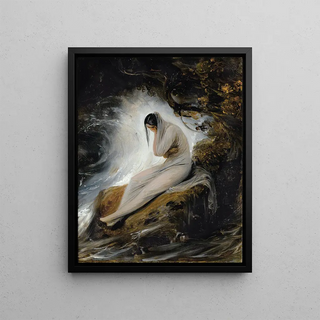Art print | The Lament of Young Girls - Horace Vernet


View from behind

Frame (optional)
In the captivating world of art, some works manage to capture the very essence of human emotion. "The Lament of Young Girls" by Horace Vernet is one of those creations that transcends time. This canvas, imbued with melancholy and beauty, immerses us in a visual narrative where the young women, central figures, express poignant sadness. Through their posture and gazes, Vernet invites us to share a moment of intimacy, a reflection on the desires and hopes of youth. This piece, delicate in nature, proves to be a true mirror of souls, where every detail tells a unique story.
Style and uniqueness of the work
Horace Vernet's art stands out for its ability to combine realism and romanticism. In "The Lament of Young Girls," the chosen color palette evokes an atmosphere that is both gentle and melancholic. The shades of blue and pink, subtly blended, create a setting conducive to introspection. Vernet excels in rendering emotions, and each face of his protagonists is a painting in itself, revealing rare psychological depth. The drapery of the clothing, carefully crafted, adds a tactile dimension to the work, inviting the viewer to come closer. The composition, meanwhile, is skillfully orchestrated, with each element finding its place in a harmonious balance. Thus, the piece becomes not only a testament to Vernet's technique but also an exploration of human feelings, oscillating between joy and sadness.
The artist and his influence
Horace Vernet, born in 1789, was a painter whose artistic journey was marked by a deep commitment to his era. Influenced by the artistic movements of his time, he managed to forge a unique style, combining the realism of genre scenes with romantic sensitivity. Vernet succeeded in establishing himself in the art world through his depictions of everyday life, but also through his historical works. His talent for capturing human emotion inspired many subsequent artists, making him an essential figure of the 19th century. "The Lament of Young Girls"

Matte finish

View from behind

Frame (optional)
In the captivating world of art, some works manage to capture the very essence of human emotion. "The Lament of Young Girls" by Horace Vernet is one of those creations that transcends time. This canvas, imbued with melancholy and beauty, immerses us in a visual narrative where the young women, central figures, express poignant sadness. Through their posture and gazes, Vernet invites us to share a moment of intimacy, a reflection on the desires and hopes of youth. This piece, delicate in nature, proves to be a true mirror of souls, where every detail tells a unique story.
Style and uniqueness of the work
Horace Vernet's art stands out for its ability to combine realism and romanticism. In "The Lament of Young Girls," the chosen color palette evokes an atmosphere that is both gentle and melancholic. The shades of blue and pink, subtly blended, create a setting conducive to introspection. Vernet excels in rendering emotions, and each face of his protagonists is a painting in itself, revealing rare psychological depth. The drapery of the clothing, carefully crafted, adds a tactile dimension to the work, inviting the viewer to come closer. The composition, meanwhile, is skillfully orchestrated, with each element finding its place in a harmonious balance. Thus, the piece becomes not only a testament to Vernet's technique but also an exploration of human feelings, oscillating between joy and sadness.
The artist and his influence
Horace Vernet, born in 1789, was a painter whose artistic journey was marked by a deep commitment to his era. Influenced by the artistic movements of his time, he managed to forge a unique style, combining the realism of genre scenes with romantic sensitivity. Vernet succeeded in establishing himself in the art world through his depictions of everyday life, but also through his historical works. His talent for capturing human emotion inspired many subsequent artists, making him an essential figure of the 19th century. "The Lament of Young Girls"






